Magnetic, Phonon and Optical Properties of Transition Metal and Rare Earth Ion Doped ZnS Nanoparticles
Abstract
1. Introduction
2. The Model and the Green’s Functions
3. Results and Discussion
4. Conclusions
Author Contributions
Funding
Data Availability Statement
Conflicts of Interest
References
- Fang, X.; Zhai, T.; Gautam, U.K.; Li, L.; Wu, L.; Bando, Y.; Golberg, D. ZnS nanostructures: From synthesis to applications. Progr. Mater. Sci. 2011, 56, 175–287. [Google Scholar] [CrossRef]
- Hwang, J.M.; Oh, M.O.; Kim, I.; Lee, J.K.; Ha, C.S. Preparation and characterization of ZnS based nano-crystalline particles for polymer light-emitting diodes. Curr. Appl. Phys. 2005, 5, 31. [Google Scholar] [CrossRef]
- Yokoyama, M.; Chen, N. ALE growth and optical characterization of ZnSe/ZnS strained quantum well structures on Si substrate. J. Crystal Growth 2001, 223, 369. [Google Scholar] [CrossRef]
- Liu, X.; Cai, X.; Mao, J.; Jin, C. ZnS/Ag/ZnS nano-multilayer films for transparent electrodes in flat display application. Appl. Surf. Sci. 2001, 183, 103. [Google Scholar] [CrossRef]
- Sapsford, K.E.; Pons, T.; Medntz, I.L.; Mattoussi, H. Sensors 2006, 6, 925.
- Kapsalis, V.; Kyriakopoulos, G.; Zamparas, M.; Tolis, A. Investigation of the photon to charge conversion and its implication on photovoltaic cell efficient operation. Energies 2021, 14, 3022. [Google Scholar] [CrossRef]
- Donne, A.L.; Jana, S.K.; Banerjee, S.; Basu, S.; Binetti, S. Optimized luminescence properties of Mn doped ZnS nanoparticles for photovoltaic applications. J. Appl. Phys. 2013, 113, 014903. [Google Scholar] [CrossRef]
- Mamiyev, Z.; Balayeva, N.O. Metal Sulfide Photocatalysts for Hydrogen Generation: A Review of Recent Advances. Catalysts 2022, 12, 1316. [Google Scholar] [CrossRef]
- Shukla, V.; Singh, M. Room temperature luminescence and ferromagnetism from transition metal ions: Mn-, Co- and Ni-doped ZnS nanoparticles. Mater. Sc. Eng. B 2022, 280, 115685. [Google Scholar] [CrossRef]
- Kaur, N.; Kaur, S.; Singh, J.; Rawat, M. A Review on Zinc Sulphide Nanoparticles: From Synthesis, Properties to Applications. J. Bioelectron. Nanotechnol. 2016, 1, 5. [Google Scholar]
- Akhtar, M.S.; Malik, M.A.; Alghamdi, Y.G.; Ahmad, K.S.; Riaz, S.; Naseem, S. Chemical bath deposition of Fe-doped ZnS thin films: Investigations of their ferromagnetic and half-metallic properties. Mater. Sci. Semicond. Proc. 2015, 39, 283. [Google Scholar] [CrossRef]
- Wei, M.; Yang, J.; Yan, Y.; Cao, J.; Zuo, Q.; Fu, H.; Wang, B.; Fan, L. The investigation of the maximum doping concentration of iron in zinc sulfide nanowires, and its optical and ferromagnetic properties. Superlatt. Microstr. 2013, 54, 181. [Google Scholar] [CrossRef]
- Kumar, S.; Chen, C.L.; Dong, C.L.; Hob, Y.K.; Lee, J.F.; Chan, T.S.; Thangaveld, R.; Chen, T.K.; Mok, B.H.; Rao, S.M.; et al. Room temperature ferromagnetism in Ni-doped ZnS nanoparticles. J. All. Comp. 2013, 554, 357. [Google Scholar] [CrossRef]
- Kumar, S.; Verma, N.K. Structural, Optical and Magnetic Investigations on Fe-Doped ZnS Nanoparticles. J. Mater. Sci. Mater. Electron. 2015, 26, 2754. [Google Scholar] [CrossRef]
- Sambasivam, S.; Joseph, D.P.; Reddy, D.R.; Reddy, B.K.; Jayasankar, C.K. Synthesis and characterization of thiophenol passivated Fe-doped ZnS nanoparticles. Mater. Sci. Eng. B 2008, 150, 125. [Google Scholar] [CrossRef]
- Xie, R.S.; Liu, L.Y.; Li, L.H.; Li, Y.L.; Chen, Q.A.; Yue, X.; Xiao, D.Q.; Zhu, J.G. Aqueous synthesis of thiol-capped water-soluble Fe-doped ZnS nanocrystals. In Proceedings of the 2010 3rd International Nanoelectronics Conference (INEC), Hong Kong, 3–8 January 2010; pp. 769–770. [Google Scholar]
- Chen, H.X.; Shi, D.N.; Qi, J.S.; Wang, B.L. First-principles study on the magnetic properties of transition-metal atoms doped (ZnS)12 cluster. J. Magn. Magn. Mater. 2011, 323, 781. [Google Scholar] [CrossRef]
- Jindal, S.; Sharma, P. Magnetic and optical properties of transition metal (Fe, Co) and rare-earth (Tb, Dy) doped ZnS nanoparticles. J. Alloy Compd. 2021, 879, 160383. [Google Scholar] [CrossRef]
- Rao, M.R.; Kumar, R.J. Photoluminescence and Magnetic studies of Ce and Mn co-doped Zinc Sulfide Nanoparticles prepared by chemical coprecipitation method. J. Inform. Comput. Sci. 2020, 10, 120. [Google Scholar]
- Sambasivam, S.; Joseph, D.P.; Lin, J.G.; Venkateswaran, C. Doping induced magnetism in Co-ZnS nanoparticles. J. Solid State Chem. 2009, 182, 2598. [Google Scholar] [CrossRef]
- Li, Y.; Cao, C.; Chen, Z. Magnetic and optical properties of Fe doped ZnS nanoparticles synthesized by microemulsion method. Chem. Phys. Lett. 2011, 517, 55. [Google Scholar] [CrossRef]
- Saikia, D.; Raland, R.D.; Borah, J.P. Influence of Fe doping on the structural, optical and magnetic properties of ZnS diluted magnetic semiconductor. Physica E 2016, 83, 56. [Google Scholar] [CrossRef]
- Chandrasekar, L.B.; Chandramohan, R.; Vijayalakshmi, R.; Chandrasekaran, S. Preparation and characterization of Mn-doped ZnS nanoparticles. Int. Nano Lett. 2015, 5, 71. [Google Scholar] [CrossRef]
- Sahu, M.K. Semiconductor Nanoparticles Theory and Applications. Int. J. Appl. Eng. Res. 2019, 14, 491. [Google Scholar]
- Hasanzadeh, J.; Shayesteh, S.F. Optical and structural characterisation of Cu doped CdS (CdS:Cu) nanoparticles. Eur. Phys. J. Appl. Phys. 2010, 51, 30601. [Google Scholar] [CrossRef]
- Rana, M.S.; Das, S.K.; Rahman, M.O.; Ahmed, F.; Hossain, M.A. Vanadium Doped ZnS Nanoparticles: Effect of Vanadium Concentration on Structural, Optical and Electrical Properties. Trans. Electr. Electr. Mater. 2021, 22, 612. [Google Scholar] [CrossRef]
- Muthukumaran, S.; Kumar, M.A. Structural, FTIR and photoluminescence properties of ZnS:Cu thin films by chemical bath deposition method. Mater. Lett. 2013, 93, 223. [Google Scholar] [CrossRef]
- Goudarzi, A.; Aval, G.M.; Park, S.S.; Choi, M.C.; Sahraei, R.; Ullah, M.H.; Avanes, A.; Ha, C.S. Low-Temperature Growth of Nanocrystalline Mn-Doped ZnS Thin Films Prepared by Chemical Bath Deposition and Optical Properties. Chem. Mater. 2009, 21, 3738. [Google Scholar] [CrossRef][Green Version]
- Inamdar, A.I.; Lee, S.; Kim, D.; Gurav, K.V.; Kim, J.H.; Im, H.; Jung, W.; Kim, H. Metal-doped ZnS(O) thin films on glass substrates using chemical bath deposition. Thin Solid Films 2013, 537, 36. [Google Scholar] [CrossRef]
- Ramasamy, V.; Praba, K.; Murugadoss, G. Synthesis and study of optical properties of transition metals doped ZnS nanoparticles. Spectrochim. Acta Part A 2012, 96, 963. [Google Scholar] [CrossRef]
- Boulkroune, R.; Sebais, M.; Messai, Y.; Bourzami, R.; Schmutz, M.; Blanck, C.; Halimi, O.; Boudine, B. Hydrothermal synthesis of strontium-doped ZnS nanoparticles: Structural, electronic and photocatalytic investigations. Bull. Mater. Sci. 2019, 42, 223. [Google Scholar] [CrossRef]
- Poornaprakash, B.; Chalapathi, U.; Vattikuti, S.V.P. Compositional, morphological, structural, microstructural, optical, and magnetic properties of Fe, Co, and Ni doped ZnS nanoparticles. Appl. Phys. A 2017, 123, 275. [Google Scholar] [CrossRef]
- Abdalla, A.M.; Ali, A.M.; Kawaguchi, N.; Yanagida, T. Detection of ionizing radiation using Ag-doped ZnS nanoparticles. J. Mater. Sci. Mater. Electr. 2022, 33, 2450. [Google Scholar] [CrossRef]
- Archana, L.S.; Rajendran, D.N. Luminescence of rare earth doped ZnS nanophosphors for the applications in optical displays. Mater. Today Proc. 2021, 41, 461. [Google Scholar] [CrossRef]
- Varughese, G.; Usha, K.T.; Kumar, A.S. Zinc Sulphide nanomaterials doped with rare earth Neodymium—An Optical study. Int. J. Eng. Sci. Innov. Technol. 2014, 3, 206. [Google Scholar]
- Nasser, R.; Elhouichet, H.; Ferid, M. Effect of Mn doping on structural, optical and photocatalytic behaviors of hydrothermal Zn1-xMnxS nanocrystals. Appl. Surf. Sci. 2015, 351, 122. [Google Scholar] [CrossRef]
- Mamiyev, Z.Q.; Balayeva, N.O. Optical and structural studies of ZnS nanoparticles synthesized via chemical in situ technique. Chem. Phys. Lett. 2016, 646, 69–74. [Google Scholar] [CrossRef]
- Li, X.; Xu, W.; Wang, Y.; Zhang, X.; Hui, Z.; Zhang, H.; Wageh, S.; Al-Hartpmy, O.A.; Al-Sehemi, A.G. Optical-intensity modulators with PbTe thermoelectric nanopowders for ultrafast photonics. Appl. Mater. Today 2022, 28, 101546. [Google Scholar] [CrossRef]
- Lin, Z.; Hong, M. Femtosecond Laser Precision Engineering: From Micron, Submicron, to Nanoscale. Ultrafast Sci. 2021, 22, 9783514. [Google Scholar] [CrossRef]
- Kim, J.H.; Rho, H.; Kim, J.; Choi, Y.-J.; Park, J.-G. Raman spectroscopy of ZnS nanostructures. J. Raman Spectr. 2012, 43, 906. [Google Scholar] [CrossRef]
- Harish, G.S.; Reddy, P.S. Synthesis and characterization of Ce, Cu co-doped ZnS nanoparticles. Physica B 2015, 473, 48. [Google Scholar] [CrossRef]
- Trajic, J.; Kostica, R.; Romcevic, N.; Romcevic, M.; Mitric, M.; Lazovic, V.; Balaz, P.; Stojanovic, D. Raman spectroscopy of ZnS quantum dots. J. Alloy Compd. 2015, 637, 401. [Google Scholar] [CrossRef]
- Yang, R.; Tripathy, S.; Tay, F.E.H.; Gan, L.M.; Chua, S.J. Photoluminescence and micro-Raman scattering in Mn-doped ZnS nanocrystalline semiconductors. J. VacuumSci. Techn. B 2003, 21, 984. [Google Scholar] [CrossRef]
- Qadri, S.B.; Skelton, E.F.; Hsu, D.; Dinsmore, A.D.; Yang, J.; Gray, H.F.; Ratna, B.R. Size-induced transition-temperature reduction in nanoparticles of ZnS. Phys. Rev. B 1999, 60, 9191. [Google Scholar] [CrossRef]
- Sun, Q.; Shen, X.P.; Chen, K.M.; Liu, Q.; Liu, W. Low-temperature synthesis of hexagonal ZnS nanoparticles by a facile microwave-assisted single-source method. Solid State Commun. 2008, 147, 501. [Google Scholar] [CrossRef]
- Acharya, S.A.; Maheshwari, N.; Tatikondewar, L.; Kshirsagar, A.; Kulkarni, S.K. Ethylenediamine-Mediated Wurtzite Phase Formation in ZnS. Cryst. Growth Des. 2013, 13, 1369. [Google Scholar] [CrossRef]
- Brafman, O.; Mitra, S.S. Raman Effect in Wurtzite- and Zinc-Blende-Type ZnS Single Crystals. Phys. Rev. 1968, 171, 931. [Google Scholar] [CrossRef]
- Bean, C.P.; Livingston, J.D. Superparamagnetism. J. Appl. Phys. 1959, 30, 120. [Google Scholar] [CrossRef]
- Singh, R. Unexpected magnetism in nanomaterials. J. Magn. Magn. Mater. 2013, 346, 58. [Google Scholar] [CrossRef]
- Kumar, S.; Mandal, P.; Singh, A.; Husain, S.; Kumar, D.; Malik, V.K.; Sharma, S. Magnetization properties of Co incorporated ZnS nanocrystals synthesized at low temperature via chemical route. J. Alloy Compd. 2020, 830, 154640. [Google Scholar] [CrossRef]
- Patel, P.C.; Ghosh, S.; Srivastava, P.C. Antiferromagnetic coupling in Co-doped ZnS. J. Mater. Sci. 2015, 50, 7919. [Google Scholar] [CrossRef]
- Patel, P.C.; Srivastava, P.C. Fe doping in ZnS for realizing nanocrystalline-diluted magnetic semiconductor phase. J. Mater. Sci. 2014, 49, 6012. [Google Scholar] [CrossRef]
- Reddy, D.A.; Murali, G.; Vijayalakshmi, R.P.; Reddy, B.K. Room-temperature ferromagnetism in EDTA capped Cr-doped ZnS nanoparticles. Appl. Phys. A 2011, 105, 119. [Google Scholar] [CrossRef]
- Hu, Y.C.; Lou, Y.; Lu, B.; Shao, M.; Ni, J.; Cao, M. A New Simple Route to ZnS Quantized Particles with Tunable Size and Shape, and Size/Shape-Dependent Optical Properties. Adv. Mater. Phys. Chem. 2013, 3, 10. [Google Scholar] [CrossRef]
- Rufat, J. Properties in Fe-Doped ZnS Thin Films. Res. Devel. Mater. Sci. 2021, 16, 1779. [Google Scholar] [CrossRef]
- Bhattacharya, S.; Chakravorty, D. Electrical and magnetic properties of cold compacted iron-doped zinc sulfide nanoparticles synthesized by wet chemical method. Chem. Phys. Lett. 2007, 444, 319. [Google Scholar] [CrossRef]
- Ho, C.-H.; Varadhan, P.; Wang, H.-H.; Chen, C.-Y.; Fang, X.; He, J.-H. Raman selection rule for surface optical phonons in ZnS nanobelts. Nanoscale 2016, 8, 5954. [Google Scholar] [CrossRef]
- Khamala, B.; Franklin, L.; Malozovsky, Y.; Stewart, A.; Saleem, H.; Bagayoko, D. Calculated Electronic, Transport, and Bulk Properties of zinc-blende Zinc Sulphide (zb-ZnS). Comput. Condens. Matter 2016, 6, 18. [Google Scholar] [CrossRef]
- Duwarah, H.; Sharma, N.; Saikia, K.K.; Datta, P. International Conference on Frontier Computing; Springer: Singapore, 2023; Volume 404. [Google Scholar]
- Al-Rasoul, K.T.; Ibrahim, I.M.; Ali, I.M.; Al-Haddad, M. Synthesis, structure and characterization of ZnS quantum dots and using photocatalytic reaction. Int. J. Sci. Technol. Res. 2013, 3, 213. [Google Scholar]
- Djelloul, A.; Adnane, M.; Larbah, Y.; Sahraoui, T.; Zegadi, C.; Maha, A.; Rahal, B. Properties study of ZnS thin films prepared by spray pyrolysis method. J. NanoElectr. Phys. 2015, 7, 04045. [Google Scholar]
- Mohammadikish, M.; Davar, F.; Loghman-Estarki, M.R. Low Temperature Preparation of 3D Solid and Hollow ZnS Nanosphere Self-Assembled from Nanoparticles by Varying Sulfur Source. J. Clust. Sci. 2013, 24, 217. [Google Scholar] [CrossRef]
- Krishna, P.H.; Jagwani, D.; Ramrakhiani, M. Theoretical Study of Photo-Luminescence Emission Using the Line Shape Function for Semiconductor Quantum Dots. J. NanoElectr. Phys. 2021, 13, 01024. [Google Scholar] [CrossRef]
- Abdelkader, B. Electronic and optical properties of transition metals doped ZnS: First principles study. J. Optoel. Adv. Mater. 2016, 18, 1018–1026. [Google Scholar]
- Khan, M.S.; Shi, L.; Zou, B.; Ali, S. Teoretical investigation of optoelectronic and magnetic properties of Co doped ZnS and (Al, Co) co-doped ZnS. Comput. Mater. Sci. 2020, 174, 109491. [Google Scholar]
- Viswanath, R.; Naik, H.S.B.; Somalanaik, Y.K.G.; Neelanjeneallu, P.K.P.; Harish, K.N.; Prabhakara, M.C. Studies on Characterization, Optical Absorption, and Photoluminescence of Yttrium Doped ZnS Nanoparticles. J. Nanotechnol. 2014, 2014, 924797. [Google Scholar]
- Sakthivel, P.; Muthukumaran, S.; Ashokkumar, M. Structural, band gap and photoluminescence behaviour of Mn-doped ZnS quantum dots annealed under Ar atmosphere. J. Mater. Sci. Mater. Electr. 2015, 26, 1533–1542. [Google Scholar] [CrossRef]
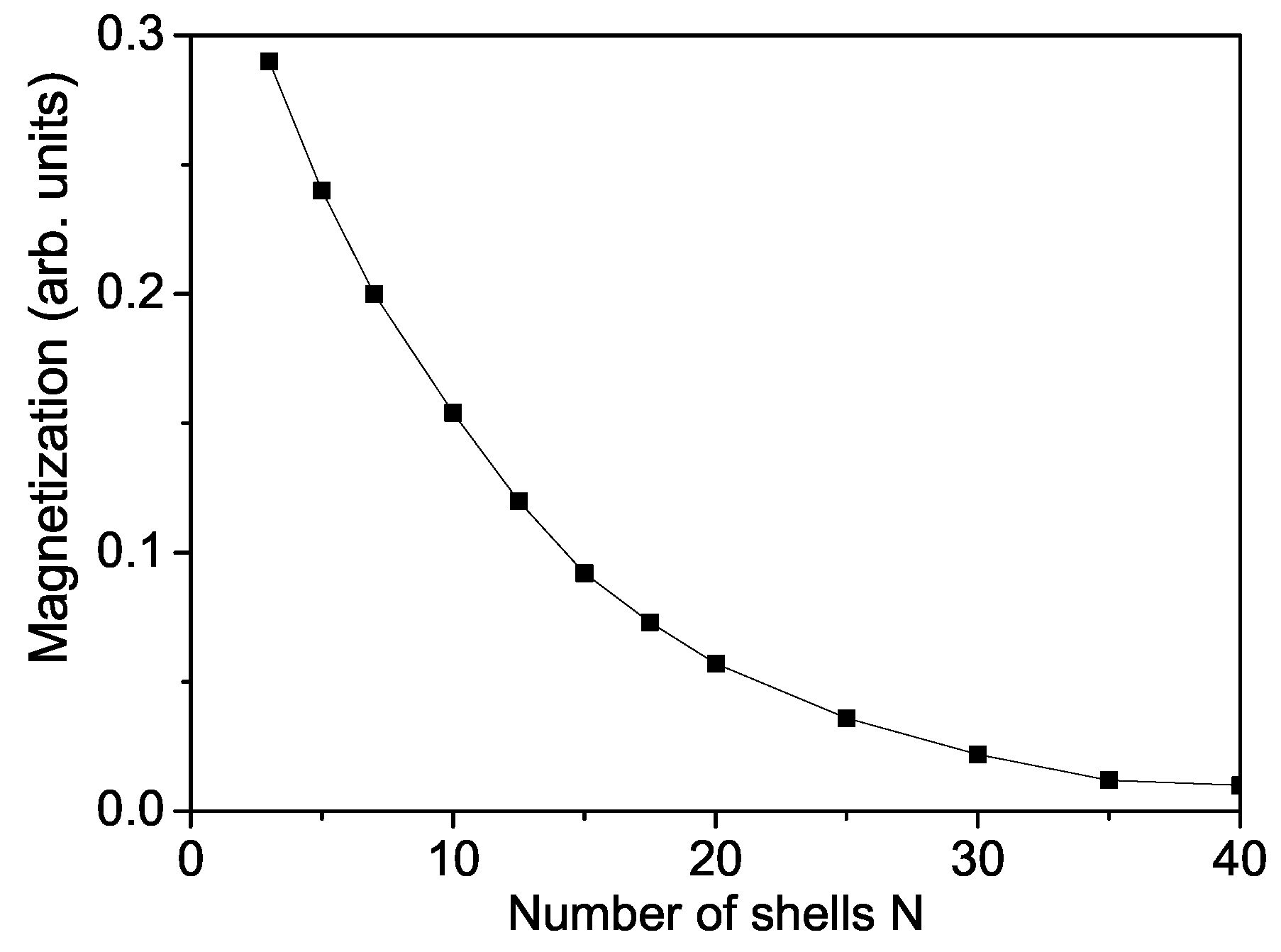
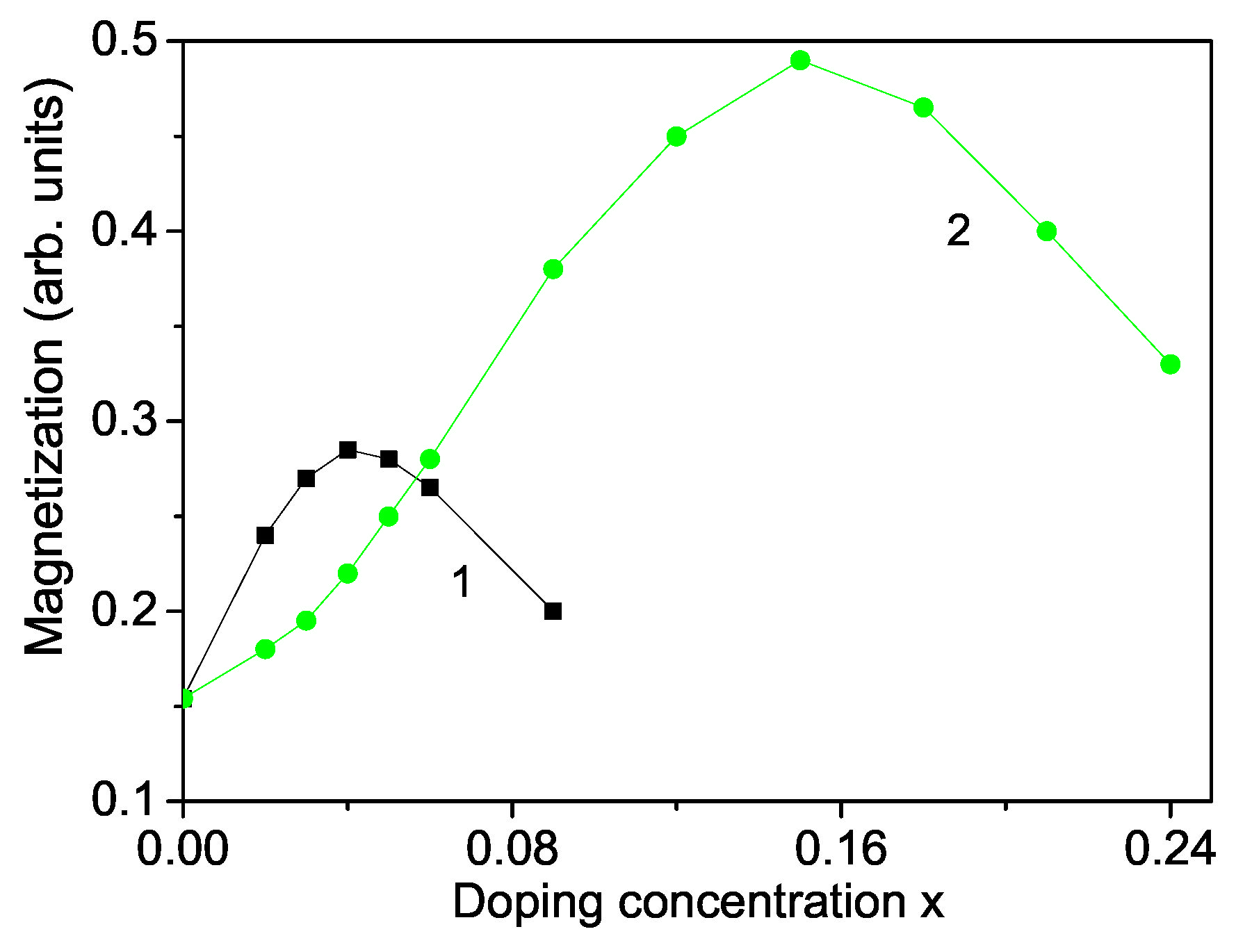
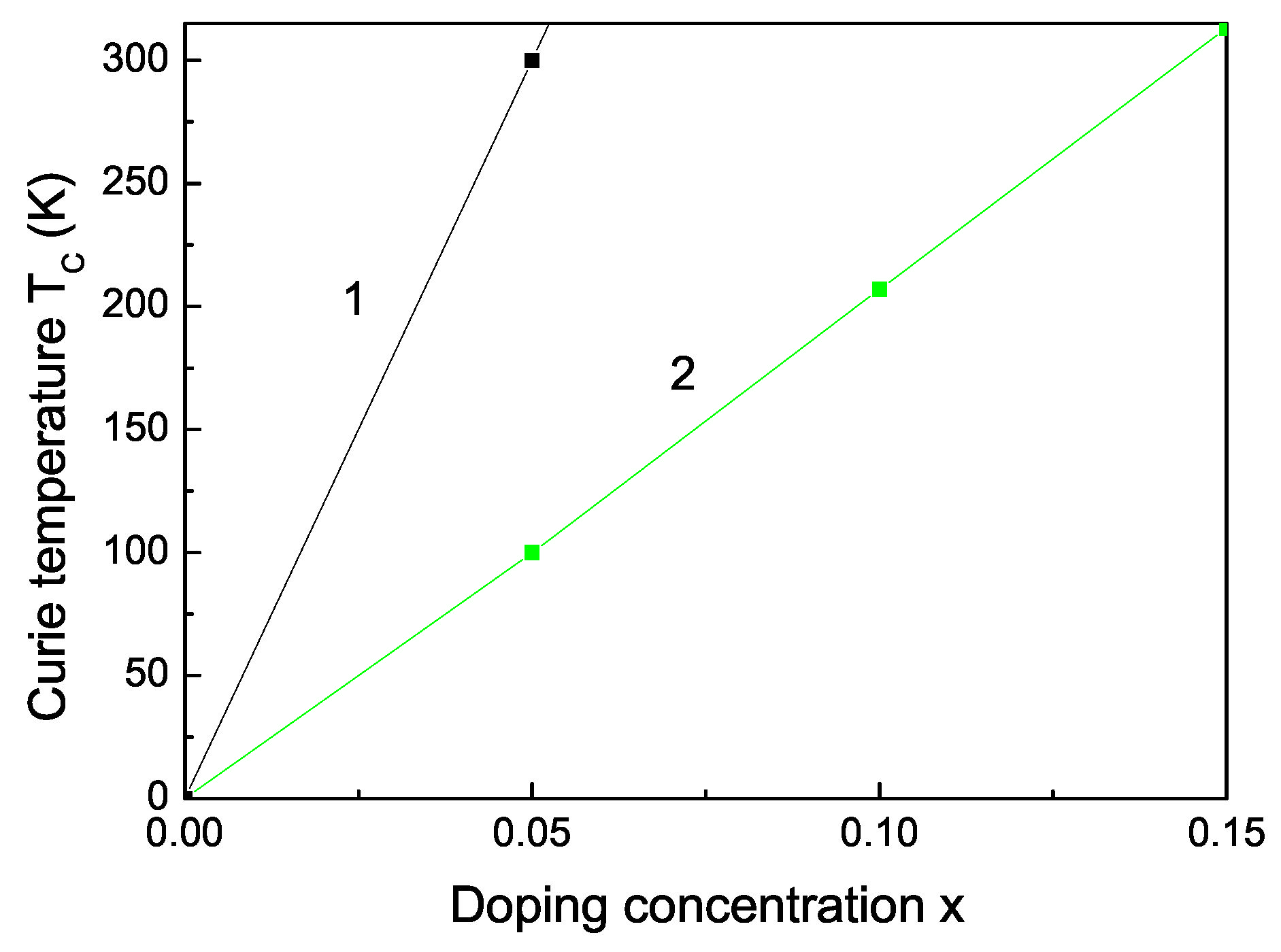
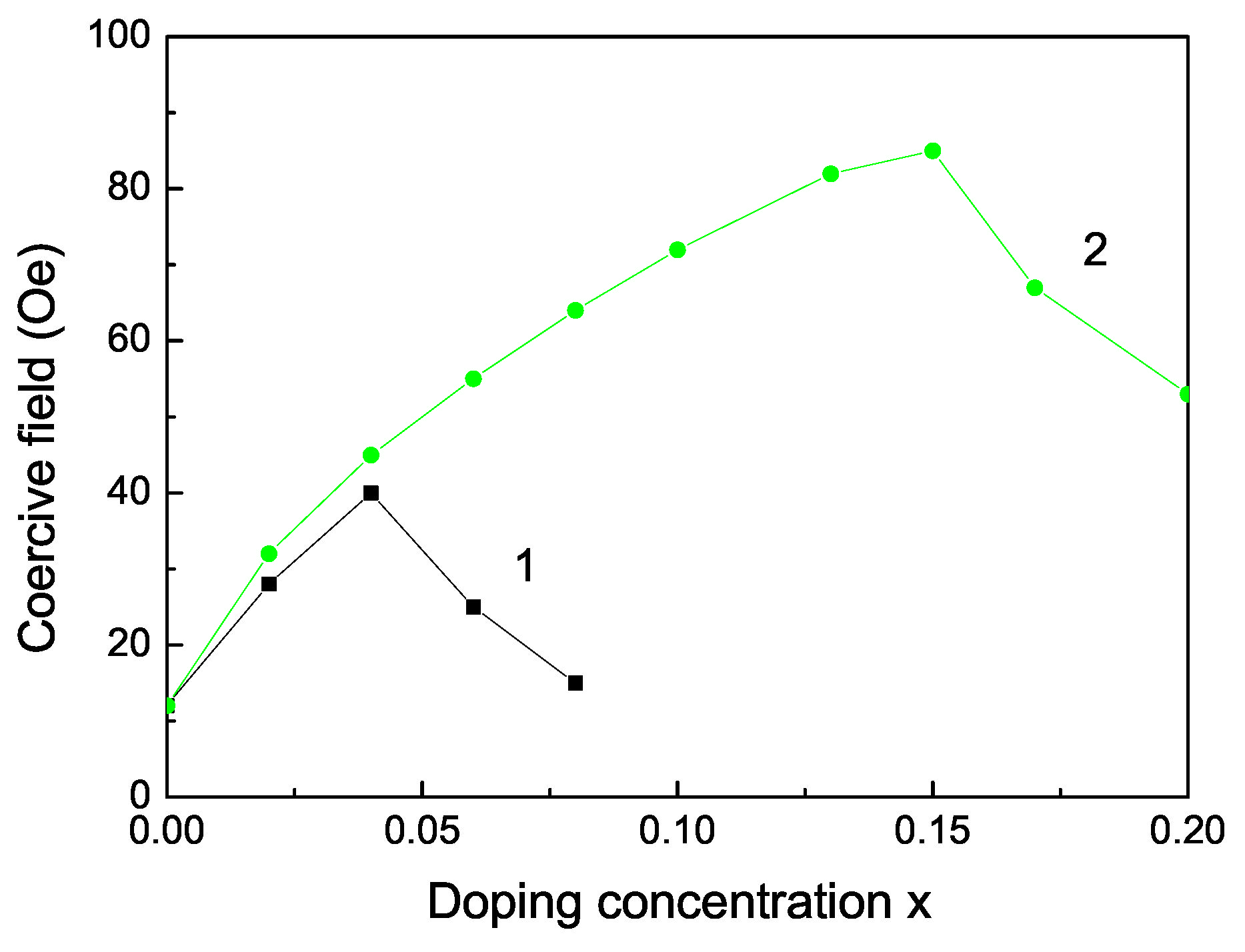

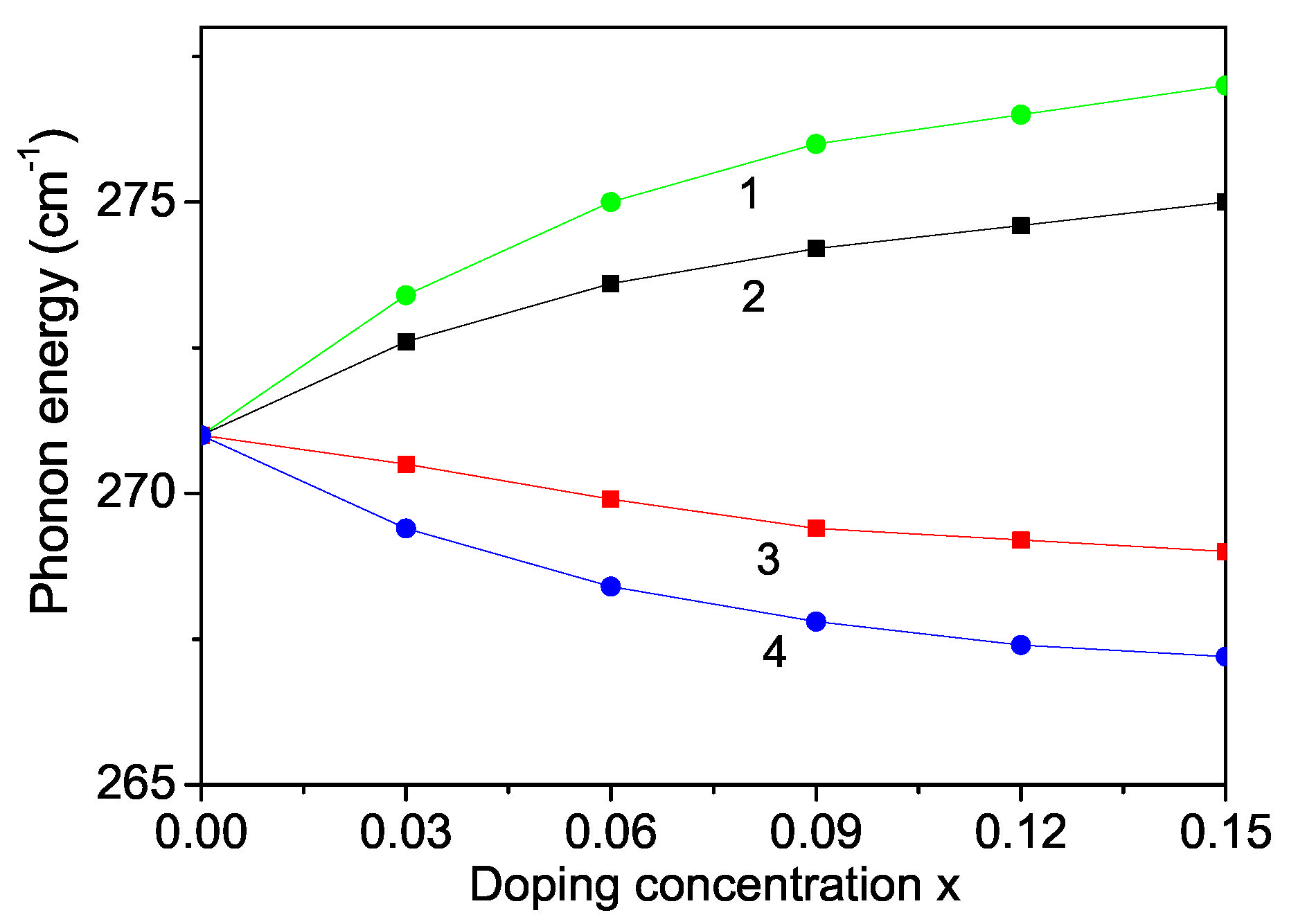

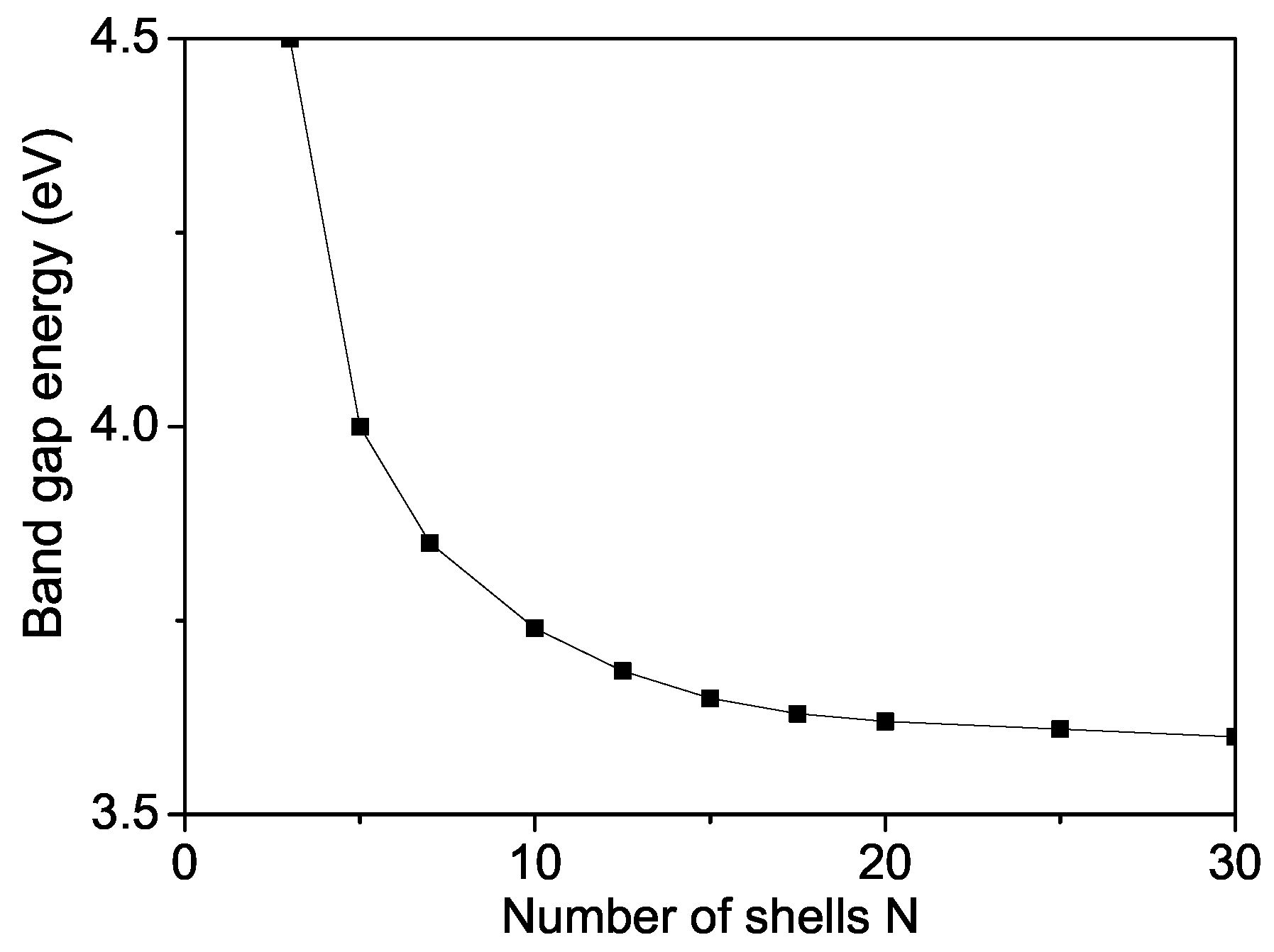
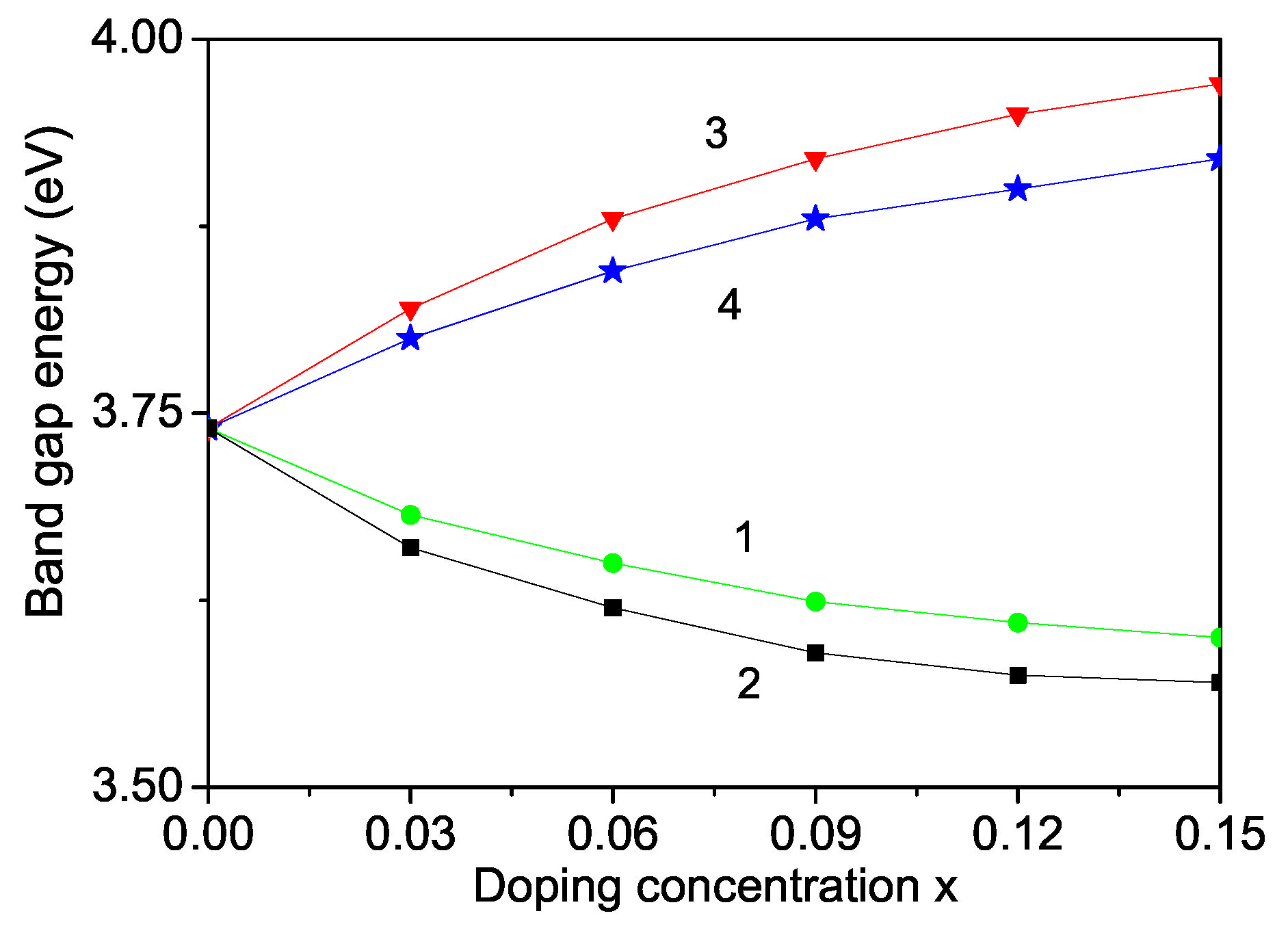
Disclaimer/Publisher’s Note: The statements, opinions and data contained in all publications are solely those of the individual author(s) and contributor(s) and not of MDPI and/or the editor(s). MDPI and/or the editor(s) disclaim responsibility for any injury to people or property resulting from any ideas, methods, instructions or products referred to in the content. |
© 2022 by the authors. Licensee MDPI, Basel, Switzerland. This article is an open access article distributed under the terms and conditions of the Creative Commons Attribution (CC BY) license (https://creativecommons.org/licenses/by/4.0/).
Share and Cite
Apostolova, I.; Apostolov, A.; Wesselinowa, J. Magnetic, Phonon and Optical Properties of Transition Metal and Rare Earth Ion Doped ZnS Nanoparticles. Nanomaterials 2023, 13, 79. https://doi.org/10.3390/nano13010079
Apostolova I, Apostolov A, Wesselinowa J. Magnetic, Phonon and Optical Properties of Transition Metal and Rare Earth Ion Doped ZnS Nanoparticles. Nanomaterials. 2023; 13(1):79. https://doi.org/10.3390/nano13010079
Chicago/Turabian StyleApostolova, Iliana, Angel Apostolov, and Julia Wesselinowa. 2023. "Magnetic, Phonon and Optical Properties of Transition Metal and Rare Earth Ion Doped ZnS Nanoparticles" Nanomaterials 13, no. 1: 79. https://doi.org/10.3390/nano13010079
APA StyleApostolova, I., Apostolov, A., & Wesselinowa, J. (2023). Magnetic, Phonon and Optical Properties of Transition Metal and Rare Earth Ion Doped ZnS Nanoparticles. Nanomaterials, 13(1), 79. https://doi.org/10.3390/nano13010079





